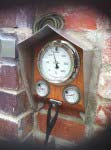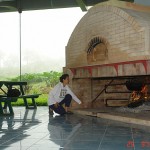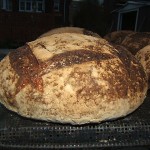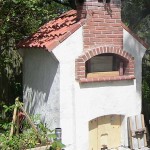Refractory mortar and wood fired ovens
Mortar making and applications. Refractory heat resistant mortar types for building wood fired ovens from fire clay bricks.
In building high quality oven, refractory mortar should be used in only up to ¼" (6mm) thick application. That's the general rule but there are 2 or 3 exceptions. Mortar only assists in forming firing chamber and logically shouldn't be used or left exposed on the hot-face.
Refractory mortar may not be applied for plugging holes or big spaces or gaps between firebricks. Clay body of refractory firebricks does face the heat. Higher mortar thickness applied always shrinks (* more information further down). Shrinkage would create space and increased brick movement / gap difference between cold state and the state expanded by heat on material reheating.
Every time this gap happens bricks change position, just a little bit but enough to cause rebuilding job in the future.
Linear shrinkage in re-fired mortar is of up to 8%
There may be a thicker mortar application possible if such a place is located further away from the hot face. For instance plugging a cavity. In such a situation, the advice would be mixing a firebrick grog into the mortar. It would be an approach which causes lesser shrinkage. However, if the place requires structural stability and strength under some heat, then wedging with firebrick off-cut is obviously much more appropriate and professional.
To elaborate even further, the next option would be using a refractory concrete or coarse castable. These can be either mixed at home or purchased in a form of readily available pre-mixed products - they consist of firebrick grog as the aggregate volume and some common heat resistant bonding agents such as refractory cement.

Before work with firebricks and fireclay based
mortar dip bricks in water
Refractory mortar mixing formulas
10 : 3 : 1.5 - Sand, Calcium Aluminate cement, Fireclay.
If you found hard locating refractory cement don't worry, here is one mixing formula with Portland cement plus lime available in ordinary building stores.
There are two Portland cement types, get the common gray in color, the other one is white decorative used for around pools etc. where a white effects are required.
Lime is calcium it takes over the cement in hot conditions (Portland will gradually burn out, it is used only for the mortar to set while working.)
10 : 6 : 2 : 3 – Sand, Fire Clay, Portland cement, and Lime.
First mix all dry ingredients well. Then in small amounts start adding clean water at room temperature while continuing mixing.
Mix into peanut butter consistency. Apply thinly between firebricks and only in those places where needed e.g. in "V" sections between arched bricks on outside. Inside the arch - these bricks should be in line next to each other touching without gaps.
No need for mortar between floor and wall bricks, in barrel shape dome you will not use too much mortar in arch too - it's very easy. However, if you build a round dome make sure you don’t get spaces in between bricks exposing mortar on inside the dome and big thickness of mortar on outside - start to angle cut bricks as soon as gaps begin to occur.
Conclusion
In any case, on the inside of a dome's hot-face there should not be any unnecessary gaps within the firebrick work. Only a small amount of mortar should always be used for the brick structure to stay strong and stable. When buying firebricks ask your refractory supplier about that too. You might even be able to buy a quality premix airset heat resistant mortar in a bucket for joining firebricks, they are good (these products aren't dear, plus not too much will be needed for one oven job, so of course go for it and buy the bucket. Most commercial mortars do not require soaking firebricks in water before work starts, so read the instruction on its packaging.) Exposed mortar in the dome could detach in time, peel off, from the inner surfaces. Especially so when it is a fire-clay based mortar - the fire clay explained.
I hope you find the refractory heat resistan mortar information useful.
by Rado Hand
Related: learn more about:
- Which dome is better - a round igloo shape or a rectangle?
- Refractory mortar - kinds and mixing formula's for making your own
- Dome cladding layer - for efficiency and durability
- Thermal insulation - types and mixing formula's




